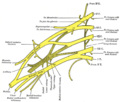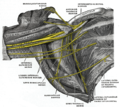Lower subscapular nerve: Difference between revisions
CSV import |
CSV import |
||
| Line 34: | Line 34: | ||
[[Category:Nervous system]] | [[Category:Nervous system]] | ||
[[Category:Peripheral nervous system]] | [[Category:Peripheral nervous system]] | ||
<gallery> | |||
File:Gray807.png|Lower subscapular nerve | |||
File:Brachial_plexus.svg|Brachial plexus diagram | |||
File:Gray809.png|Lower subscapular nerve | |||
File:Brachial_plexus_color.svg|Brachial plexus color diagram | |||
</gallery> | |||
Latest revision as of 05:01, 18 February 2025
Lower subscapular nerve
The Lower subscapular nerve is a nerve in the human body that supplies the subscapularis muscle and the teres major muscle. It is a branch of the brachial plexus.
Etymology[edit]
The term "subscapular" comes from Latin "sub" meaning under and "scapula" meaning shoulder blade. The term "nerve" comes from Latin "nervus" meaning sinew or tendon.
Anatomy[edit]
The lower subscapular nerve arises from the posterior cord of the brachial plexus. It carries fibers from the C5 and C6 roots. It is a motor nerve which supplies the lower part of the subscapularis muscle and the teres major muscle.
Function[edit]
The lower subscapular nerve controls the contraction of the subscapularis and teres major muscles. These muscles are involved in the internal rotation of the shoulder joint.
Clinical significance[edit]
Damage to the lower subscapular nerve can result in weakness in the internal rotation of the shoulder joint and difficulty in adducting the arm.
See also[edit]
References[edit]
<references />




